
A Dictionary of the Fuchsia™
Want to know what those mysterious terms mean and just who the people were behind those names? Then this is the place for you.
Want to know what those mysterious terms mean and just who the people were behind those names? Then this is the place for you.
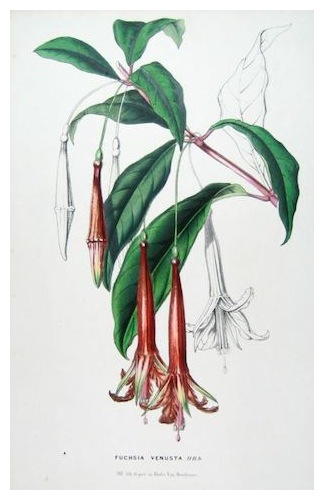
Tachira – Referring to the state of Táchira, located in north-western Venezuela on its border with Colombia. Fuchsia x tachira appears to be invalid as a formally published taxon and apparently refers to a naturally occurring hybrid between Fuchsia gehrigeri x Fuchsia venusta, both found in the state. With the addition of Fuchsia nigricans and Fuchsia verrucosa, four species are sympatric to the Venezuelan Andes and all possible putative hybrid combinations between these species, excepting Fuchsia verrucosa, have been observed there by botanists. These hybrids are, however, usually not assigned names.
(Illustration: Fuchsia venusta (Humboldt, Bonpland & Kunth 1823) drawn by Louis van Houtte in Flore des serres et des jardin de l’Europe, Vol. 5, p. 538 (1849)

(Illustration: Compare left, F. denticulata Ruiz & Pav. [as F. serratifolia Ruiz & Pav.] from Edwards’s Botanical Register, vol. 31: t. 41 (1845) and, right, Passiflora mollisima (Kunth) L.H. Bailey as Tacsonia mollissima Kunth from Edwards’s Botanical Register, vol. 32: t. 11 (1846). Both drawings are by Sarah Drake (1803-1857), one of the most accomplished botanical illustrators of her time.)
Tamaensis – From Tama-Tama in Venezuela. Fuchsia verrucosa var. tamaensis (Steyerm. 1952) is a synonym of Fuchsia verrucosa (Hartw. ex Benth. 1845) in ➤ Section Verrucosa.
Taxa – See Taxon.
Taxon – Any group of plants with the same name. The term's correct Latin plural is taxa. The plural taxons, however, is also often used in English, especially in non-scientific writings or informal contexts.
Taxonomy – The science of classifying plant and animals into an ordered system of groups and categories to indicate natural relationships.
Tenella – Small, delicate, tender. Fuchsia tenella (Lindl.) G.Don 1830) is a synonym of Fuchsia magellanica (Lam. 1788) in ➤ Section Quelusia.
Terete – Having a smooth circular cross-section; cylindrical. When referring to a plant stem it usually, but not necessarily, might imply a tapering form.
Ternate – Said of leaves when arranged in groups or whorls of three around the stem. Many fuchsias will often have stems with opposite pairs of leaves along with ones with ternately arranged leaves. Cuttings taken from the ternate stems are desirable because they will result in bushier plants more quickly.
Tetrad – In Botany, a group of four cells, such as spores or pollen grains, formed by the division of one mother cell. Pollen of Fuchsia, along with that of other members of the Onagraceae family, is characteristically shed in tetrads. See Pollen.
Tetradactyla – Having four fingers or digits. Fuchsia tetradactyla (Lindl. 1846) is an unresolved name or synonym. See also Fuchsia encliandra subsp. tetradactyla in ➤ Section Encliandra.
Tetragonous - Having four sides as in a tetragon; quadrilateral.
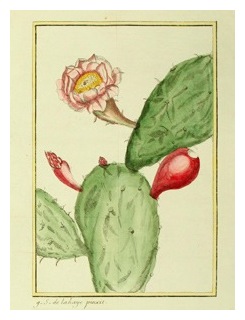

Sensing something amiss, however, the viceroy Antonio María de Bucareli y Ursúa ordered him to leave, unwilling "to open to strangers the secrets of the country". Imagining himself a modern counterpart of Jason and the Golden Fleece, he quietly slipped over the ramparts of the city and set out for Oaxaca, source of the best cochineal dyes, claiming to be a Catalan in order to disguise his French-accented Spanish and his dress. There he finally managed to purchase some cochineal insects and cactus pads from the locals.
Adding other valuable commercial plants, such as vanilla pods, the Ipomea purga he had noted in Veracruz, indigo and cotton seeds, all jumbled among the nondescript herbal specimens in his collecting case, he returned to Saint-Domingue. Back at Port-au-Prince, Thiéry started a nopalry in the Jardin du Roi, the botanical garden that he established there, and sent further specimens of his insects and pads to the scientific academy at Cap-Français. With the great success of his adventure he was
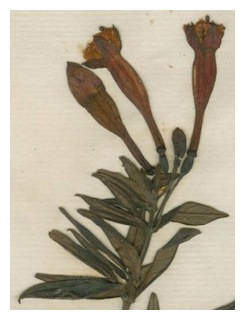
Thiéry sought to establish a potentially lucrative commercial industry for the French government in his quest for cochineals. Interestingly, it was Charles Plumier, the botanist who had undertaken three successful missions to the Caribbean about a hundred years earlier and had also been appointed a Royal Botantist for his work, who had definitively proven that the cochineal was an insect from his observations on Martinique.
Among the plant specimens Thiéry collected on Hispaniola was also Fuchsia triphylla, the first fuchsia discovered and described by Plumier as well. This Thiéry collection is still preserved at the Linnean Society of London. It is in the Society's Smith Herbarium among forty-three other botanical specimens from Saint-Domingue ascribed to him. Undated, it would probably have been collected sometime between Thiéry's return to Saint-Domingue in 1778 and his death at Port-au-Prince in 1780.
(Illustration: 1 & 2. Opuntia ficus-indica and top and bottom views of female cochineals, Traité de la culture du nopal, et de l'éducation de la cochenille dans les colonies-françaises de l'Amérique; précédé d'un Voyage a Guaxaca, 1787; 3. Detail from the dried herbarium specimen identified as Fuchsia triphylla and preserved at the Linnean Society of London.)
Thierry, "Baron" Charles de – See ➤ Heraldry.
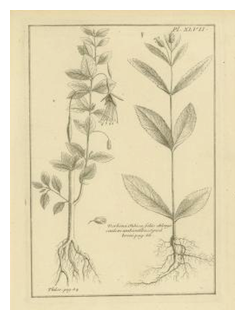
Fuchsia magellanica would be first formally described as a Fuchsia when Lamarck officially published the species in 1788. Feuillée was oddly inaccurate in stating that thilco had five-petalled flowers and illustrated ten stamens coming out of them instead of eight. It was this mistake that would lead Juan Ignacio Molina (1740-1829) to publish thilco not as a Fuchsia but as Thilcum tinctorium in 1810.
The name is also spelled thilko, tilco and tilko. It should be noted that the "th" phoneme in thilco is meant to represent the consonant in the Mapudungun languages called a "voiceless retroflex stop" ( ʈ ) and not the "voiceless dental stop" ( t̪ ) of English, as is usually assumed by English speakers. This means that thilco is more properly pronounced to match the English word "time" (ʈaɪm), not "thin" (t̪ʰɪn). In fact, a good comparison is the pronunciation of the herb, thyme.
Thilco, meaning Fuchsia magellanica, should also not be mistaken for the confusingly named and apparently natural hybrid, Fuchsia magellanica x Fuchsia lycioides 'Thilco'.
See also Chilco, Feuillée, Magellanica, Molin, Thilcum tinctorium.
(Illustration: Thilco is on the left of part of the page in Feuillée's Journal. A verbena appears to the right.)

Molina wrote much about his beloved native country during his many years of exile in Italy. He and his fellow Jesuits had been expelled from Chile in 1768, sadly forever denying him a return. In establishing Thilcum tinctorium, Molina seems to have been in Italian exile too long to fully recollect thilco on his own and was unfortunately misled by inaccuracies in Louis Feuillée's report of it in the Journal des observations physiques, mathématiques, et botaniques (Paris, 1714).
Feuillée wrongly states that its flowers are five-petalled and depicts ten stamens coming out of each flower. Molina explicitly cites Feuillée's authority for creating the new genus reasoning that, while other authors report that the genus Fuchsia has four-petalled flowers and eight stamens, Feuillée indicates five for thilco: Thilco could therefore not be a Fuchsia.
Molina doesn't seem to have been aware that Lamarck had already published F. magellanica in 1788. He was aware of its synonym, F. macrostemma (Ruiz & Pavon 1802), however, and of other fuchsias published under the name Coccinea.
Thilcum tinctorium is now synonymous with F. magellanica (Lamarck 1788).
(Illustration: Entry page of Thilco tinctorium in the second edition (1810) of Juan Ignacio Molina's Saggio sulla storia naturale del Chili.)
Thompsonii – Possibly named in honor of Irish naturalist, William Thompson (1805-1852). F. thompsonii (Koehne 1893) is a synonym of F. magellanica (Lam. 1788) in ➤ Section Quelusia. Fuchsia magellanica ‘Thompsonii’ is also a commonly gown cultivar.
Thunderbug, Thunderfly – Frankliniella occidentallis. See Western Flower Thrips.
Thrips – Frankliniella occidentallis. See Western Flower Thrips.
Thymifolia – Having leaves resembling those of the thyme plant (Thymus). See F. thymifolia in ➤ Section Encliandra, of which there are two subspecies.
Tillett, Stephen S. (b. 1930) – Tillet is an American botanist and specialist on the Passifloriaciae family, who collected botanical specimens in Peru and Venezuela. He is associated with the Universidad Central de Venezuela and the Missouri Botanical Garden. Tillett made the first collection a new fuchsia species which is now named in honor as Fuchsia tilletiana (Munz 1972). See Fuchsia tillettiana in ➤ Section Hemsleyella.
Tillettiana – Named in honor of Stephen S. Tillett (b. 1930). See: Tillet; Fuchsia tillettiana in ➤ Section Hemsleyella.
Tincta – Colored. See Fuchsia tincta in ➤ Section Fuchsia.
Tinctorium – Indicates that the plant is used in dyeing, or has sap which can stain. See Thilcum tinctorium.
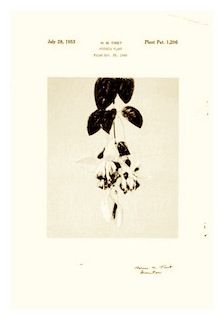
‘Rubeo' would be his public debut and was well-received when it was sold commercially at La Rochette in 1947. His many noteworthy plants were developed according to his self-described "five-year plan." Tiret's magnum opus was certainly 'Swingtime' (1950), which has became one of the most popular fuchsias of all time. 'Voodo,' released in 1953, is another plant that might also sit at the of any list. In 1954, Tiret was awarded the American Fuchsia Society's Medal of Achievement. In all, he released just under 130 plants from 1947 into the early 70’s.
Among his hybrids are many other names instantly recognized by fuchsia followers:
Amethyst (1941), Desert Rose (1946), Rubeo, Santa Cruz (1947), Ecstasy, Jack Shahan,
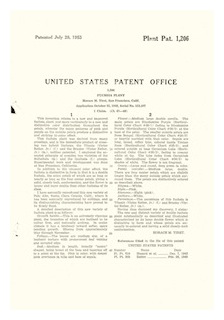
(Illustration: Tiret's USPP No. 1206 listing him as the "inventor" of a new fuchsia. The application was filed in 1949 and granted in 1953. Although the plant is un-named, the patent lists Reiter's 'Titanic' as the female parent and 'Brazier' as the male; the description seems to match 'Sharon'.)
Tomentose – Covered in hairs.
Townsendii – Named in honor of Charles H. T. Townsend (1865-1944), American entomologist who worked in the United States, Mexico, Brazil and Peru. While his primary interest was insects, especially Diptera, he also widely collected plants on his field trips. Fuchsia townsendii (I.M.Johnst. 1925) is a synonym of Fuchsia ayavacensis (Kunth 1823) in ➤ Section Fuchsia.
Toxicity – All parts of fuchsias are non-toxic to humans. See Edibility, Recipes.
Trailer – A fuchsia with a lax habit good for growing in hanging baskets or being trained into a standard.
Training – Also termed shaping. See also.
Transpiration – The emission of water vapor from plant leaves.
Tree Fuchsia – Common name for Fuchsia excorticata in ➤ Section Skinnera, or occasionally, for Fuchsia arborescens in ➤ Section Schufia. F. excorticata is also known in New Zealand by its native Maori name, Kotukutuku. There are additionally a number of unrelated plants often popularly, but inaccurately, called "tree fuchsias." See ➤ Faux Fuchsias.
Tribe – A taxonomic rank placed between a family and a genus. In the case of families divided into subfamilies, the tribe lies below the subfamily. In large families, they are occasionally divided into subtribes. The standard ending of tribe names is -eae. Fuchsia is placed in the Circaeeae tribe of the Onagroideae subfamily within the Onagraceae family (see also).
Triphylla – Having leaves in sets of three. Fuchsia triphylla, flore coccineo… (Three-leaved, scarlet-flowered fuchsia…) was the first fuchsia discovered and described by Charles Plumier on Hispaniola in about 1696-97. Plumier's long descriptive name was later shortened to Fuchsia triphylla by Linnaeus in accordance with his binomial system.
Contrary to what is stated in many references, Plumier does not seem to have sent any actual plant material to be grown in Europe. About 1730, however, Philip Miller (see also) received the seeds of a fuchsia shipped from "Carthagena in New Spain" [sic] from fellow Scotsman and botanist William Houstoun. This fuchsia, identified with Plumier's species, was apparently successfully grown at the Chelsea Physic Garden for a number of years before disappearing from cultivation at some point. Since Miller was head gardener from 1722 to 1771, it's unclear at what date the plant was lost. Unfortunately, no preserved specimen has survived and there is some doubt that it was actually Fuchsia triphylla as Houston collected in modern Venezuela, not Hispaniola.
Lost for many years, Fuchsia triphylla was rediscovered when seeds collected in Haiti in the 1870s for the New York nurseryman, Thomas Hogg, Jr. (see also), were sent to Kew for identification in 1882. Carl Bonstedt (see also) would use it to breed a range of new hybrids in Germany from about 1904 to 1915.
See Fuchsia triphylla in ➤ Section Fuchsia; Triphylla Hybrids.

(Illustration: Fuchsia 'Gartenmeister Bonstedt.')
Tube – The elongated part of the calyx. Its correct scientific name is the hypanthium.
Tuber – Tubers are enlarged plant structures that store nutrients to help the plant survive over winter or through other seasonally dry months. They provide the plant with both energy and nutrients for regrowth during the next active growing season. Tubers can be formed by plants from both modified stems and roots and should not be confused with rhizomes, which are only formed from modified stems. Some fuchsia species, such as F. pachyrizza or F. apetala, have evolved to develop tuberous roots most likely in response to the harsher ecological conditions of their habitats. See also rhizomes.
Tuberosa – Tuberous. Fuchsia tuberosa (K.Krause 1905) is a synonym of Fuchsia salicifolia (Hemsl. 1876) in ➤ Section Hemsleyella.
Tunariensis – Meaning either from the Cerro Tunari, a volcano in the Tunari National Park, in the Cochabamba Department of Bolivia, or from Villa Tunari (Tunari), a small town also in the same Department. See Fuchsia tunariensis in ➤ Section Hemsleyella.
Turgid – In botany, a plant with swollen tissues that are filled with moisture.
Type Species – In taxonomy, the species to which a genus is anchored, often the first one described when it was established. In botany, the type species is usually a physical specimen or drawing. Fuchsia triphylla is the type species for Fuchsia.
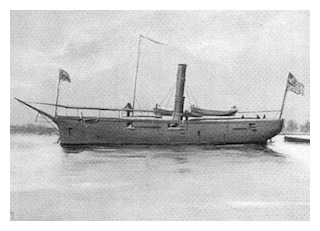
(Illustration: USS Fuchsia, US Government Printing Office, 1897.)
Umbrosa – Shady. F. umbrosa (Benth. 1845) is a synonym of F. loxensis (Kunth 1823) in ➤ Section Fuchsia.
Unduavensis – From Unduavi in La Paz Department, Bolivia. F. unduavensis (Munz 1943)is a synonym of F. apetala (Ruiz & Pav. 1802) in ➤ Section Hemsleyella.
Uniflora – Single flowered. F. uniflora (Sessé & Moç. 1888) is a synonym of F. microphylla (Kunth 1823) in ➤ Section Encliandra.
University of Leicester National Collection of Hardy Fuchsia – See National Collections (UK).
Upright – A fuchsia, especially a cultivar, that exhibits mostly stiff vertical growth that makes it suitable for growing as a bush or shrub in the ground or in a pot.

He worked as Eichler's assistant on the Flora Brasiliensis and lated succeeded him as editor, when he died in 1887, until the completion of the work in 1906. In 1884, Urban started work with Leopold Krug on his Puerto Rican collections and their collaboration produced the nine-volume Symbolae Antillanae (1898-1928), one of Urban’s most important contributions to botany, and his thirty-volume Sertum Antillanum.
Urban's herbarium, estimated at 80,000 or more sheets, was tragically destroyed in 1943 when the Berlin Herbarium was bombed by the Allies during the Second World War.
Nestled among Urban’s many Caribbean contributions in the Symbolae Antillaniae was a new fuchsia species from Santo Domingo on Hispaniola, described in 1899 as Fuchsia pringsheimii (see also). The name was in honor of fellow German botanist and founder of the German Botanical Society, Nathanael Pringsheim (1823-1894), who had only recently died (see also). The original collection was made by Henrik [Heinrich] Baron von Eggers (1844–1903). Eggers was a Danish military officer posted to the Danish Antilles (US Virgin Islands since 1917) who became a botanist after retirement. He botanized extensively in the Caribbean and was in Santo Domingo in 1887 (Eggers No. 2159).
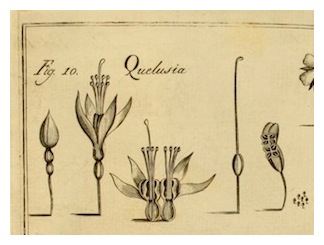
Pombal lured him back again in 1765, this time to teach at the University of Coimbra, which was being reformed by the Marquês and where Vandelli found a better class of students for his teaching. He was the first director of the Botanical Garden at Coimbra until 1791, when he retired from the University. In 1793 he became the first director of the Ajuda Botanical Gardens in Lisbon. He was also one of the founders of the Academia Real das Ciências de Lisboa. Vandelli remained in Portugal for most of his long career contributing much with his studies and many publications and holding a number of important positions.
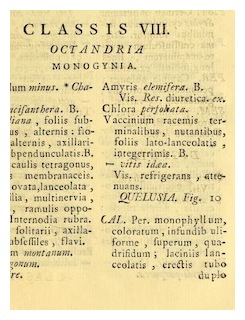
Florae was based partly on the work of the noted Brazillian botanist and secular Jesuit priest, Joaquim Veloso de Miranda (1733-1815), who was born in the town of Inficionado (today called Santa Rita Durão) in Minas Gerais. From a wealthy family of land and mine owners, Veloso de Miranda came to Portugal to study at the University of Coimbra, and later to teach alongside Vandelli. He later returned to his native Brazil where he botanized for a number of years.
Among the collections sent back to Vandelli might logically have been the relatively rare F. coccinea . It is endemic to only a few mountain ridges in Minas Gerais near his home town and base of study. Vandelli's entry might possibly have been based on a number of other similarly flowered Quelusia section fuchsias, such as F. regia ssp. regia also endemic to parts of Minas Gerais, but the concurrent spread of F. coccinea to areas such as St. Helena and Madiera does seem point to it as the fuchsia behind Quelusia. Vandelli also makes reference to Forster's Skinnera (Forster & Forster 1776), now F.excorticata, in his Florae.
Vandelli's later life would be far from the quiet and studious retirement he probably envisioned. Much of Europe was in turmoil during the Napoleanic Wars (1803-1815) and French armies would invade the Iberian Penninsula to occupy most of Portugal. Moments before the capture of Lisbon in 1807, the entire Portuguese royal family and court (by some estimates up to 15,000 people in all) fled into exile in Brazil with the help of the British Royal Navy. Remaining in Portugal, Vandelli apparently belonged to the liberal, pro-French faction in the country.
Acting against Britain's trade interests and foreign policies—which had essentially turned Portugal and its colonies into British protectorates—Vandelli actively collaborated with the French even helping them transfer valuable museum collections, such as the important specimens from Brazil, to Paris. With the gradual defeat of French forces and the arrival of the Duke of Wellington in Lisbon in 1810, the aged Vandelli was arrested and summarily deported to the Azores on the frigate Amazona, along with a number of others. It was only due to the intercession of Sir Joseph Banks and his other friends at the Royal Society in London, of which he was a member, that he was transferred to exile in England. The two men had become friends when Banks had stayed in Lisbon for six months in 1766. He was only allowed to return to Portugal in 1815.
N.B. Vandelli is not to be confused with Domenico Vandelli (1691-1754), an Italian cartographer, scientist and mathematician of the name.
(Illustrations: 1. Detail Fig. 10. Quelusia (F. coccinea) from Vandelli's Florae Lusitanicae et Brasiliensis specimen, 1788; 2. Detail from Page 23 starting the treatment of Quelusia. It continues onto page 24.)
Vargas Calderón, Julio (1903/1905-2002) – César Vargas was a Peruvian botanist at the University of Cuzco. He was active exploring and collecting the flora of Peru from 1936-1967. Among his many collections were at least a dozen fuchsia species, including one new to science, discovered in 1936 growing between Yanamayo and Tambomayo in the Cuzco Department of Peru, that was to be dubbed F. vargasiana by Paul Munz (1946). He was intensely interested in the conservation of Peru's wildlife and 143 species in various genera were to be named in his honor. See F. vargasiana in ➤ Section Fuchsia.
Vargasiana – Named in honor of Julio César Vargas Calderón (1903 or 1905-2002). See: Vargas; F. vargasiana in ➤ Section Fuchsia.

(Illustration: 'Tom West.')
Variety or Varietas – In botanical classification, a taxonomic rank just below the level of a species but not as important as a subspecies. Varieties have different appearances but hybridize easily. The name should not be confused with cultivars, or cultivated varieties, as varieties occur naturally. The term may often be used imprecisely by horticulturalists, such as when speaking of "grape varieties." Outside of taxonomy, a plant variety may also have a statutory definition that differs from its botanical one.
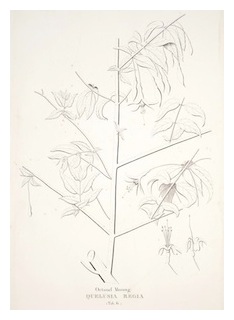
(Illustration: Unpainted plate of Quelusia regia [F. regia], tab. 6 in vol. 4 of the Icones of Florae Fluminensis, 1825-1827.)
Veloso de Miranda, Joaquim (1733-1815) – Veloso de Miranda was a noted Brazillian botanist and secular Jesuit priest who was born in the town of Inficionado (today called Santa Rita Durão) in Minas Gerais. From a wealthy family of land and mine owners, Veloso de Miranda came to Portugal to study at the University of Coimbra, and later to teach alongside Domenico Vandelli, before returning to his native Brazil where he botanized for a number of years. Among the collections sent back to Vandelli, which he used in his Florae Lusitanicae et Brasiliensis specimen (1788) might logically have been the relatively rare F. coccinea which is endemic to only a few mountain ridges in Minas Gerais near his home town and base. (See also Aiton, Salisbury, Vandelli.)
Velutina – Velvety. F. velutina (I.M.Johnst. 1925) is a synonym of F. corymbiflora (Ruiz & Pav. 1802) in ➤ Section Fuchsia.
Venusta – Beautiful or charming. See F. venusta (Kunth 1823) in ➤ Section Fuchsia. Fuchsia venusta var. huilensis (Munz 1943) is a synonym of F. venusta.
Venation – The pattern of veins on a leaf's surface,
Ventral – The lower surface or underside, especially of a leaf.
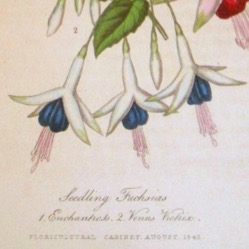
(Illustration: Detail of Fuchsia 'Venus Victrix' from Joseph Harrison. Floricultural Cabinet & Florist's Review, 1843, Volume 10, Plate 169.)
Verrucosa, verrucose – Covered in warts; warty. See F. verrucosa, the single species in Section Verrucosa,
Viscine – A sticky alkaloid substance found on pollen grains. It's purpose is to help adhere the grains together and onto pollinators so that they can be more securely transferred to other flowers for effective pollination.
Viscine Threads – Pollen from the Ornagraceae family, of which Fuchsia is a member, is characterized by viscine threads on tetrads and is easily differentiated under the microscope from that of other angiosperms, both in living plants and in the fossil record. See Pollen, Tetrad.
Vine Weevil – Otiorhynchus vulgates. The nocturnally-active Vine Weevil will eat small semicircular notches out of fuchsia leaves but this damage is mostly a cosmetic annoyance; the real damage is done after the beetle lays its eggs on the compost and its white grubs start to feed on the plant's roots. Grubs in the pots of a dormant plant can even eat the entire root system if they are carried over the winter in the compost. The slow-moving adults can be located while hunting with a flashlight at night and eliminated. But proceed more carefully in the daytime as the weevils drop down to play dead and might be hard to locate. Their shells are fairly hard so a bit of force is necessary to dispatch them. Biological controls include nematodes. Systemic and appropriately labelled grub control treatments are also effective.
Virgata – Shaped like a rod or wand; straight, long and thin; plants with a habit of straight, erect branches. Fuchsia virgata (Sweet ex Jacques 1834) is a synonym of Fuchsia magellanica (Lam. 1788) in ➤ Section Quelusia.
Voorhelm Schneevogt, George (1775-1850) – See Schneevoogt.
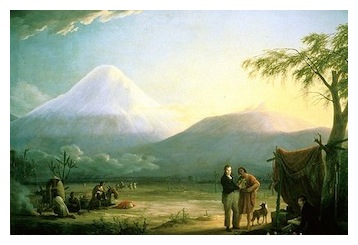
See F. vulcanica in ➤ Section Fuchsia.
(Illustration: Alexander von Humboldt and Aimé Bonpland at the foot of Chimborazo Volcano. Painting by Friedrich Georg Weitsch, oil on canvas, 1810.)
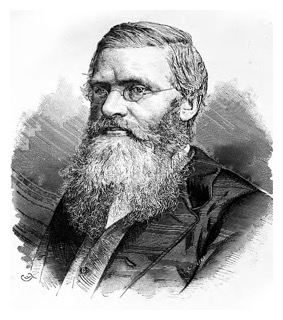

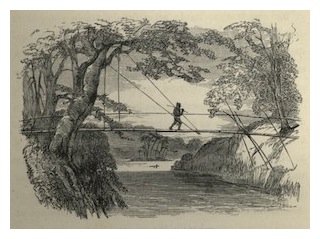
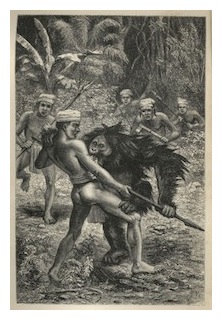
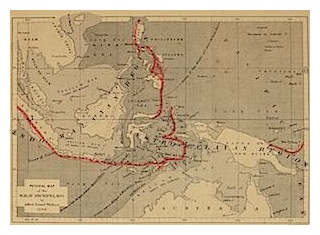

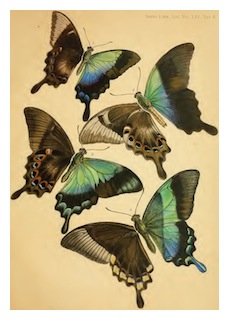
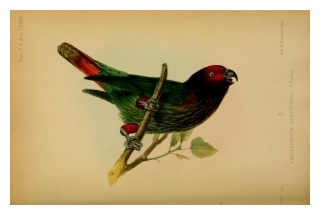
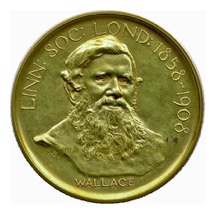
Waters, Eileen, and Dave Green – See Aquaviridis.
Web Fuchsia – Within the HTML programing of websites, full magenta is sometimes referred to as web fuchsia. The hex triplet code for both colors is #FF00FF. See also Color Fuchsia.
Weberbaueri – Named in honor of August Weberbauer (1871-1948). Fuchsia weberbaueri (E.H.L.Krause 1905) is now a synonym of F. sanctae-rosae (Kuntze 1898) in ➤ Section Fuchsia.
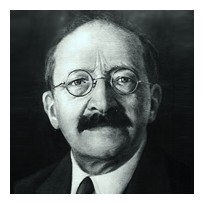
(Illustration: Archival portrait of Augusto Weberbauer from the Universidad Nacional Mayor de San Marcos, ca. 1936.)
Websites – See ➤ Fuchsia Societies and ➤ Personal Websites for full lists.
Western Flower Thrips – Frankliniella occidentallis. Also known as thunderbugs or thunderflies, among several other common names. Generally a problem that has increasingly appeared in commercial greenhouses over the last twenty years since their spread from the Southwestern United States. Western flower thrips generally live at growth tips and around the flowers, where they lay their eggs into the plant tissue. Adults and larvae suck out a plant’s sap by scraping and rasping leaf surfaces, as well as taking pollen and nectar from the flowers. Damage will be seen in the form of distorted young leaves with a crinkled surface. Other effects are a silvery discoloration, brown bumps and growth deformities. Nymphs feed on new fruit just beginning to develop from the flower. It can also carry the tomato spotted wilt virus. Introducing predatory wasps and other insects into the affected greenhouse is an effective biological control, as is the fungus Metarhizium anisopliae.
[n.b. As an interesting aside, readers that hopefully might not be familiar with these pest should note that “thrips” comes from the Greek word for “woodworm” and, like “deer” or “sheep”, is both singular and plural. There is no thrip; only a thrips. But hopefully not in your greenhouse.].
Western Fuchsia Species Society – Society devoted to the cultivation and study of species fuchsias. Based in Seattle, it is affiliated with the Northwest Fuchsia Society and maintains display gardens of locally hardy fuchsias at the Center of Urban Horticulture of the University of Washington in Seattle and at Lake Wilderness Arboretum in Maple Valley, Wash. See ➤ WFSS.
Whitefly – Trialeurodes vaporariorum. The whitefly, or sometimes ghostfly, is a very small flying insect usually found feeding on the undersides of leaves. Numbers of these insects will be seen characteristically flying off erratically in a cloud when infested plants are disturbed. The scale-like nymphs also do damage with their feeding and the resulting sugary secretions can encourage the formation of diseases as well. There are a number of treatments, both organic and chemical, to keep whitefly under control.
Wild Fuchsia – Not to be confused with any actual species growing in the wild, "Wild Fuchsia" is an occasionally heard common name for the Australian native, Eremophila maculata. It's perhaps more often referred to in Australia as the "Fuchsia Bush" or "Fuchsia Emu Bush." See Faux Fuchsias; ➤ Faux Fuchsias.

(Illustration: Williams leaving on an unidentified assignment. The Llewelyn Williams Papers, New York Botanical Garden.)
Willowherb Family – See Onagraceae.
Woytkowski, Felicks (1893-1966) – Woytkowski was a Polish botanist, entomologist and explorer who worked in Peru. Drawn by the Amazonian forest, he came to Peru with his wife and young son in 1929 but, due to the Second World War and the subsequent political situation, was not able to return to his homeland until 1964. Putting his thirty-five years in Peru to exceptional use, Woytkowski mounted over sixty expeditions into the Amazon, often in collaboration with such institutions as the Missouri Botanical Garden and the Botanical Garden of the University of California at Berkeley, collecting more than 80,000 specimens representing five thousand species. He was also director of the Botanical Garden of Lima from 1942-1945. F. woytkowskii (Macbride 1941) is now synonymous with F. rivularis subsp rivularis. See F. rivularis in ➤ Section Fuchsia.
Woytkowskii – Named in honor of Feliks (Felix) Woytkowski (1893-1966). F. woytkowskii (Macbr. 1941) is now synonymous with F. rivularis ssp rivularis (Macbr. 1940). See F. rivularis in ➤ Section Fuchsia; Woytkowski.
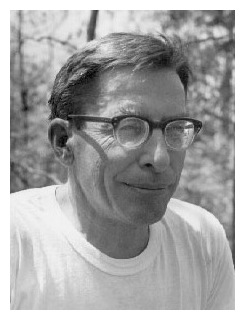
Wurdackii – Named in honor of American botanist, John. J. Wurdack (1921-1998). The type was collected by Wurdak at Quebrada Molina in the Chachapoyas Department of Peru in 1962. See F. wurdackii (Munz 1964) in ➤ Section Fuchsia; and Wurdack.
Yich' ak mut – Fuchsia paniculata in the language of the Tzotzil-speaking Maya in the highlands of Chiapas State, Mexico. See ➤ Maya.
Yunga, Yungas – The name derives from the word for "warm valley" in Quechua, the language of the Inca. Yungas is mostly a characteristically rainy, humid, and warm forest stretching along the eastern slope of the Andes Mountains in Peru, Bolivia and northern Argentina. It represents a transitional zone between the Andean highlands and the eastern lowland rain forests. There is additionally a difference in definition between Yunga and Yungas. In Peru, for example, Yunga specifically refers to an ecological climate zone divided between the Fluvial Yunga, along the eastern side of the Andes at 1,000 to 2,300 meters above the rain forest, and the Sea or Maritime Yunga, at 500 to 2,300 meters in elevation along their western side. In southwestern Bolivia and northwestern Argentina, the Southern Andean Yungas is a tropical and subtropical moist forest region full of broadleaf evergreens.
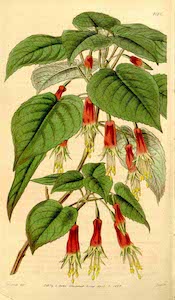
(Illustration: Fuchsia splendens. W.H. Fitch, Curtis' Botanical Magazine, vol. 70, 1844.)
Zygomorphic – See Actinomorphic.
Zygote – The cell initially formed when two gamete cells—an ovule (the female gamete) and a pollen or sperm cell (the male gamete)—are joined during sexual reproduction. During the fertilization, the two haploid gamete cells combine into a single diploid cell which now contains DNA from both parents. The zygote continues to develop until it forms a seed from which a new plant can develop. See Pollination.





